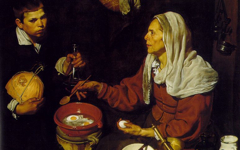The Poses of Painting
One of the many ways artists depict the creative process metaphorically is to pose figures in an unrelated setting as though they were figures in a studio. For instance, they might pose a man inside a bar holding a pipe or cigarette as if he were sitting in front of an easel holding a brush. Only those “in the know” would then recognize how the symbolism of the pose adds meaning to the conventional symbolism of smoking (which often links deep thought and imagination to the changing forms of smoke.) The artist’s own meaning is thereby conveyed in the resulting image, regardless of the patron’s wishes.
Artists at work often have their arms extended as well, either painting a canvas or striking marble with a hammer. This then allows figures with outstretched arms, with or without tools, to serve as visual metaphors for the artist. Titian made much use of this in the Renaissance and Michael Fried, a well-known expert on later art, has recognized that several figures in paintings by Caravaggio are posed like an artist. However, unaware of the tradition, Fried fails to see the full significance of his insight.{ref1} There are, of course, many other ways to use the poses of the studio in painting and sculpture, as we demonstrate in the entries below.
1. Fried, “Thoughts on Caravaggio”, Critical Inquiry 24, Autumn 1997, pp. 13-56; Fried sees such poses in Boy Bitten by a Lizard, The Martyrdom of St. Ursula, Bacchus and Salome Receiving the Head of John the Baptist.
All Articles (Alphabetical by Artist, then Title)
The Velazquez that the Louvre doesn't show anymore is not what curators think. Ask Millet, Manet, Degas, Matisse or Picasso....
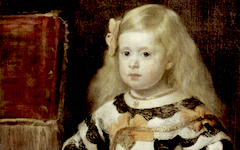
Velazquez’s Infanta Margarita (1653)
This painting of a sculptor sculpting has always confused viewers because he looks like he's drawing. Is he?
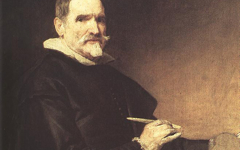
Velazquez’s Juan Martinez Montanes (1636)
Discover how the figure of an actor by Velazquez contains far more than just the figure of an actor
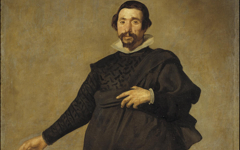
Velazquez’s Pablo de Vallodolid (1636-7)
Keep an eye on the "errors" in art and you will find the solutions
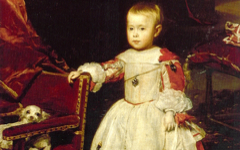
Velazquez’s Portrait of Infante Felipe Prospero (1659)
See how Velazquez portrays the artist and his art and then apply the lesson learned elsewhere

Velazquez’s Prince Baltasar Carlos with a Dwarf (1632)
This picture uses so many of the themes and methods explained on EPPH that I can note only a few. Try exercising your own perception on the rest.
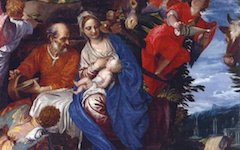
Veronese’s Rest on the Flight into Egypt (c.1572)
Everyone agrees that this work by Verrocchio breaks new ground but why? And what does it mean?

Verrocchio’s Christ and St. Thomas (1467-83)
Page 4 of 4 pages ‹ First < 2 3 4
© Simon Abrahams. Articles on this site are the copyright of Simon Abrahams. To use copyrighted material in print or other media for purposes beyond 'fair use', you must obtain permission from the copyright owner. Websites may link to this page without permission (please do) but may not reproduce the material on their own site without crediting Simon Abrahams and EPPH.
